Seabirds Count: Kevin Powers

Kevin Powers is a seabird biologist whose scientific research played a role in the designation of Stellwagen Bank National Marine Sanctuary. In 2016, he was recognized by the National Marine Sanctuary Foundation as the Volunteer of the Year for his many hours of research and exploration at the sanctuary. Powers has been happily dedicating his life to continuing marine conservation work since his retirement in 2012. This is his Story from the Blue.
While I worked as a seabird biologist at the Manomet Bird Observatory in Plymouth, Massachusetts, in the late 70s, a request came from the office of Congressman Gerry Studds. At the time, the observatory's program was the only systematic survey of birds or mammals in the Gulf of Maine. The congressman requested information on whale and seabird sightings, and our data were used in the designation of Stellwagen Bank National Marine Sanctuary.
In 1983, after the research project was completed, I left marine science for a job in the tech industry working as a software engineer. But after 35 years, I retired and got re-involved with marine conservation. I was introduced to Anne-Marie Runfola, volunteer coordinator at Stellwagen Bank, who told me about the sanctuary's seabird survey program that needed qualified volunteers. It was perfect for me – so I became a regular volunteer and seabird observer. The research coordinator at Stellwagen Bank, David Wiley, also needed someone to analyze data from a satellite-tagging program on shearwaters, and honestly, I couldn't have asked for anything better to do in retirement. I loved that I was able to put my time and passion into marine conservation work that would benefit Stellwagen Bank.
I loved that I was able to put my time and passion into marine conservation work that would benefit Stellwagen Bank.
I've even learned more about what I studied in my career as a volunteer. We have been able to track patterns of bird movements to learn how Stellwagen Bank has become an important feeding area for marine creatures.
One of the most rewarding parts of volunteer work is meeting people with similar interests to mine, as well as academics in marine ecology. All the other sanctuary volunteers share the same passion for marine conservation, and Stellwagen Bank National Marine Sanctuary offers us a great opportunity to help preserve a diverse part of our ocean while studying its species. From young to old, working with these amazing volunteers has really reinvigorated me to study seabirds and to help preserve the marine environment.
It's because of my work and the other volunteers I've met that I've been able to have so many great memories at Stellwagen. I can think of countless clear, sunny days where we have been out on our research vessel with the water teeming with marine life. Volunteering has allowed me to enjoy these experiences to the fullest and even share them with my loved ones. My son, who is now a professional biologist, remembers a time that I took him out on a boat when he was young and he saw his first humpback whale. The whale was named Olympia, and she breached very close to the boat we were on. What's so great about these memories are that anyone can have an experience like this.


